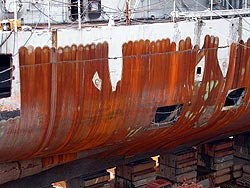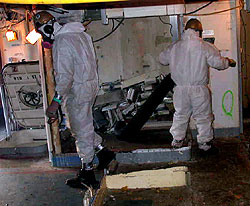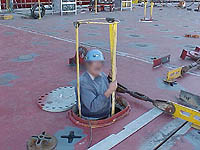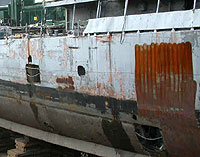Shipyard Employment eTool
Shipbreaking >> Surface Preparation for Removal of Hazardous Materials

Surface preparation in shipbreaking involves removing of hazardous materials such as paints containing polychlorinated biphenyls (PCBs) and lead as well as flammable or combustible liquids before conducting hot work or salvage operations. Methods include:
- Toxic cleaning solvents (for example, mineral spirits, diesel fuel, degreasers)
- Chemical removers (for example, paint stripper, methylene chloride)
- Mechanical removers (for example, abrasive blasting, needle gunning and grinding)

Surface preparation may range from simply wiping down equipment to totally stripping off coating. Hazards associated with surface prep may include:
- Hazardous atmospheres
- Fire and explosion hazards
- Respiratory hazards
- Corrosive and Toxic Materials (See Toxic cleaning solvents)
- Excessive noise
- Limited access
- Slips and trips
- Fall hazards
- Work environment temperature related hazards
- High-pressure hazards
- Electrical hazards
After the spaces or surfaces are evaluated and the cleaning process is complete, the shipyard must determine what personnel, equipment, and materials are required for the surface preparation and conduct a hazard assessment for PPE. See PPE for Surface Preparation. [29 CFR 1915.152(b)]
Surface Preparation and Preservation (1915 Subpart C) does not apply to shipbreaking operations, however many of the precautions in this module are good work practices to protect workers.
Note: Confined space entry is one of the leading hazards associated with barge cleaning. Review the Shipbreaking: Confined or Enclosed Spaces and Other Dangerous Atmospheres chapter for information on how to protect workers from this hazard.

Surface preparation may range from simply wiping down to totally stripping off coating. Cleaning solvents and degreasers may expose workers to the following:
- Fire and explosion hazards
- Respiratory hazards
- Contact with toxic solvents
- Limited access
- Slips and trips
- Fall hazards
- Work environment temperature related hazards
- Electrical hazards
In addition, a hazard assessment must be conducted for selecting appropriate PPE. See PPE for Surface Preparation. [29 CFR 1915.152(b)]

Chemical paint strippers and removers used for surface preparation include corrosive acids, (for example, hydrochloric and phosphoric), alkalis (for example, sodium hydroxide/lye), chlorinated hydrocarbons (for example, trichloroethane) and carcinogens (for example, methylene chloride). These chemicals may present severe eye, skin and respiratory exposure hazards.
Paint strippers and removers potentially expose workers to:
- Fire and explosion hazards
- Respiratory hazards
- Contact with toxic solvents
- Limited access
- Slips and trips
- Fall hazards
- Work environment temperature related hazards
- Electrical hazards
In addition, a hazard assessment must be conducted for selecting appropriate personal protective equipment (PPE). See PPE for Surface Preparation. [29 CFR 1915.152(b)]

Surface prep includes mechanical paint removal operations such as abrasive blasting, flame removal, use of power tools (for example, needleguns, scalers, sanding) and the use of high-pressure equipment. These operations may expose workers to:
- Fire and explosion hazards
- Respiratory Hazards
- Limited Access
- Slips and Trips
- Fall hazards. See shipbreaking fall hazards
- Work environment temperature related hazards
- High-pressure hazards
- Electrical hazards
- Excessive noise
- Impact hazards (for example, grinders and needle guns)

Some of these operations may also be considered Hot Work. In addition, a hazard assessment must be conducted for selecting appropriate PPE. See PPE for Surface Preparation. [29 CFR 1915.152(b)]

